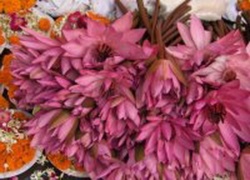Difference between revisions of "Flowers"
(Created page with "thumb|250px| Flowers (puppha or kusuma) are the reproductive structures of flowering plants and usually have brightly coloured petals and a sweet smell...") |
|||
| Line 1: | Line 1: | ||
[[File:Flowers.jpg|thumb|250px|]] | [[File:Flowers.jpg|thumb|250px|]] | ||
| − | Flowers (puppha or kusuma) are the reproductive structures of flowering plants and usually have brightly coloured petals and a sweet smell. A part of the ancient Indian betrothal ceremony consisted of bedecking the bride with garlands (M.I,286) and the making of garlands was a recognized craft (Ja.V,292). The Vinaya mentions several types of garlands, wreaths and bouquets, although the difference between these is not clear (Vin.III,179). | + | [[Flowers]] (puppha or [[kusuma]]) are the {{Wiki|reproductive}} structures of flowering [[plants]] and usually have brightly coloured petals and a sweet {{Wiki|smell}}. A part of the {{Wiki|ancient Indian}} betrothal {{Wiki|ceremony}} consisted of bedecking the bride with garlands (M.I,286) and the making of garlands was a [[recognized]] craft (Ja.V,292). The [[Vinaya]] mentions several types of garlands, wreaths and bouquets, although the difference between these is not clear (Vin.III,179). |
| − | The Buddha seems to have been a great lover of flowers judging by how often he used them as similes in his teachings. For example he said: ‘Like a beautiful flower full of colour but without perfume is the good advice dispensed by one who does not act according to it.’ (Dhp.51) and again: ‘Just as one can make many garlands from a heap of flowers, so much good can be done by one born human.’ (Dhp.53). He sometimes compared flowers with the things that we are attached to but which are nonetheless impermanent. When the informed Buddhist places flowers before the Buddha statue, he or she silently reflects on the truth of impermanence and resolves to try to see their worldly possessions in their proper perspective. See Lotus and Pūjā. | + | The [[Buddha]] seems to have been a great lover of [[flowers]] judging by how often he used them as similes in his teachings. For example he said: ‘Like a beautiful [[flower]] full of {{Wiki|colour}} but without [[perfume]] is the good advice dispensed by one who does not act according to it.’ (Dhp.51) and again: ‘Just as one can make many garlands from a heap of [[flowers]], so much good can be done by one born [[human]].’ (Dhp.53). He sometimes compared [[flowers]] with the things that we are [[attached]] to but which are nonetheless [[impermanent]]. When the informed [[Buddhist]] places [[flowers]] before the [[Buddha]] statue, he or she silently reflects on the [[truth]] of [[impermanence]] and resolves to try to see their [[worldly]] possessions in their proper {{Wiki|perspective}}. See [[Lotus]] and [[Pūjā]]. |
{{R}} | {{R}} | ||
[http://www.buddhisma2z.com/content.php?id=138 www.buddhisma2z.com] | [http://www.buddhisma2z.com/content.php?id=138 www.buddhisma2z.com] | ||
[[Category:Buddhist Terms]] | [[Category:Buddhist Terms]] | ||
Latest revision as of 21:46, 18 March 2014
Flowers (puppha or kusuma) are the reproductive structures of flowering plants and usually have brightly coloured petals and a sweet smell. A part of the ancient Indian betrothal ceremony consisted of bedecking the bride with garlands (M.I,286) and the making of garlands was a recognized craft (Ja.V,292). The Vinaya mentions several types of garlands, wreaths and bouquets, although the difference between these is not clear (Vin.III,179). The Buddha seems to have been a great lover of flowers judging by how often he used them as similes in his teachings. For example he said: ‘Like a beautiful flower full of colour but without perfume is the good advice dispensed by one who does not act according to it.’ (Dhp.51) and again: ‘Just as one can make many garlands from a heap of flowers, so much good can be done by one born human.’ (Dhp.53). He sometimes compared flowers with the things that we are attached to but which are nonetheless impermanent. When the informed Buddhist places flowers before the Buddha statue, he or she silently reflects on the truth of impermanence and resolves to try to see their worldly possessions in their proper perspective. See Lotus and Pūjā.
